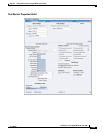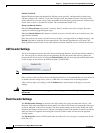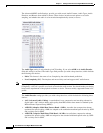
2-31
User Guide for Cisco Digital Media Encoder 2200
OL-17938-01
Chapter 2 Getting to Know the Cisco Digital Media Encoder 2200
Encoder Preset (A, B, and C)
an appliance can support multiple concurrent filters on one device if the processing per filter is light.
However, only 2 or 3 simultaneously running filters can be supported if the processing load inside or
outside the driver is particularly heavy.
Deinterlace
The Deinterlace field has four drop-down choices. These choices are Off, Auto, Inverse Telecine, and
Motion Adaptive, as you can see below.
In further explanation of each choice, please see the following definitions.
• Off —Performs no deinterlacing of any kind.
• Auto—Applies inverse telecine deinterlacing to all telecine video. Applies motion adaptive
deinterlacing to all video that is not telecine. Switches dynamically between the two modes as the
content changes. Available for NTSC video only.
• Inverse Telecine—Applies inverse telecine deinterlacing to all telecine video. Performs no
deinterlacing of video that is not telecine. Available for NTSC video only.
• Motion Adaptive—Applies motion adaptive deinterlacing to all video.
Deinterlace settings are applied and stored per-device and are applied to all filters and pins associated
with a device.
Motion Adaptive Deinterlace
Motion adaptive deinterlace is an algorithm for deinterlacing pure video (non-telecine) content. It
detects which portions of the image are still, and which portions are in motion, and then applies different
processing to each scenario. Motion Adaptive Deinterlace is the only type of deinterlacing that uses
Motion Threshold under Advanced Streaming Settings—Simulstream.
Telecine and Inverse Telecine
Telecine video is NTSC video which was originally created on film at 24 frames per second. In the
telecine conversion process, certain fields are repeated in a regular, recurring sequence. If a telecined
sequence is viewed directly on a progressive screen, interlacing artifacts will be visible.
The process called “inverse telecine” is the reverse of “telecine” — inverse telecine drops the redundant
fields and reassembles the video in a 24 fps progressive format. Interlacing artifacts are 100 percent
removed. If the video is viewed at 24 fps, you will see the exact timing and sequencing that was on the
original film. If the video is viewed at 30 fps, every fifth frame will be repeated. However, there will be
no deinterlacing artifacts.
Telecine and inverse telecine only apply to NTSC video. They are not used for PAL and SECAM video.
The Auto and Inverse Telecine button choices will be disabled when either PAL or SECAM is selected
as the video standard.


















